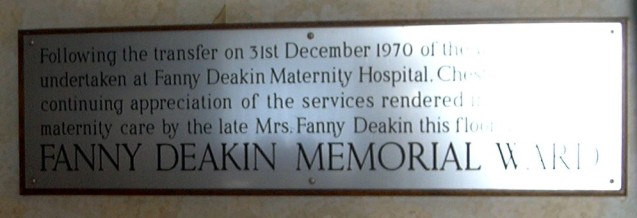Rebirth is a celebration of the move, during the spring of 2009, of the maternity department of University Hospital of North Staffordshire from the old City General Hospital maternity block, opened in 1968, to a new building. Various local artists and students from Staffordshire University responded to the call for proposals for work to contribute to the celebrations.

Following the transfer, on 31st December 1970 of the work formerly undertaken at the Fanny Deakin Maternity Hospital, Chesterton, and in continuing appreciation of the services rendered in the field of maternity care by the late Mrs Fanny Deacon this floor was named the FANNY DEAKIN MEMORIAL WARD
On a visit to the old Maternity Building I noticed a plaque on the fifth floor, which was no longer a functioning ward but had been entirely given over to administration, labelling it as the ‘Fanny Deakin Memorial Ward’. Investigating Fanny Deakin I found she had been born in 1883 and was an activist and politician from Silverdale. She was the first woman elected to Wolstanton council in 1923 where she lead a successful campaign for improved care and nutrition for mothers and babies in the desperately underprivileged local communities, which resulted in free milk being distributed by councils to pregnant women and children. Only one of her own five children survived to adulthood. She died in 1968.
In recognition of her work a local maternity hospital, opened in 1947, was named after her. It was closed in 1970 and the work subsumed into the Maternity department of the City General Hospital. So by stages the memory of Fanny Deakin and her championing of the working people of the area is fading away.
The piece is entirely sound. When the building ceases to be used, the sounds of its functioning will be lost irretrievably: the particular squeak of a particular door, the echo of footsteps in the stairwell, the clunk and tinkle of a specific person’s inimitable way of pushing the tea trolley. These sounds are so prosaic, so un-noticed and ignored, but they are totally specific and unique to the building.. To any one who worked or spent time in the building they would be intensely evocative.
In the sounds is a journey from the entrance lobby with a visiting child chatting to adults and running about, up in the lift to a functioning ward where a new-born is having a nappy change; he urinates suddenly and the nurse hoots with laughter and suggests she now needs a shower!! The phone rings and nurses and ward staff chat. We then move to the stair well and hear footsteps and other noises, from there to a floor above where banging doors and light switches echo in the emptiness. The lift then descends to the ground floor and out into the dusk where birds are cheeping sleepily in the trees and traffic passes, as do we, on our way to the new maternity facility. (I havent been able to up load the file; I need to save it in some different format, but anyhow it is about 28 minutes long and will get up here eventually)
I am interested in sound, it seems to access old, deep parts of the brain, as does smell, and somewhat bypasses the newer more rational functions.
I wanted to create an evocation of the working of old building which has now been totally lost and is almost impossible to recall or re-create. I would like to think that people who spent large amounts of time in the building would recognise some of the sounds.; the door that shouldn’t be pushed until just the right moment after the buzzer sounds, the particular voice of the lift. It might also be of interest to people who have changed from visiting that building to visiting the new one during their pregnancies.
Sounds in the new building will be completely different , despite the fact that both buildings are designed to fulfil the same function, hearing the sounds of the old building in the new one will create a kind of bridge to accompany the transfer of function from old to new.
In a hospital visitors spend quite a lot of time hanging about waiting for something to happen, in that context I think art needs to be a bit more complex and engaging than – ‘oh that’s pretty’.
I just found this page , I was wondering is it still active,
My Mother was Annie Martha O’Neill, Senior Sister Tutor at the North Staffs Maternity hospital from when it was new, I was born at the Lymes in 1959. She has some great history having trained many Midwives over 30 some years ,,
Just wonder if this site is still active .
Eamonn
The page is still active, though Im a bit slack about keeping it up! I dont have any connection with the North Staffs, was at the Art School and this was a project to ‘celebrate’ the demolishing of the old Maternity unit and the opening of the new one. I saw the plaque to Fanny Deakin and it seemed very sad that her hard work and hard times are now so forgotten,
Fanny Deakin was born not too far from where I now live. If you visit the mining memorial at Silverdale she’s featured on there.
OH thats good to know. I felt she was being very casually just forgotten, the fact that the Fanny Deakin ward was no longer in use as a ward and then the building being demolished.